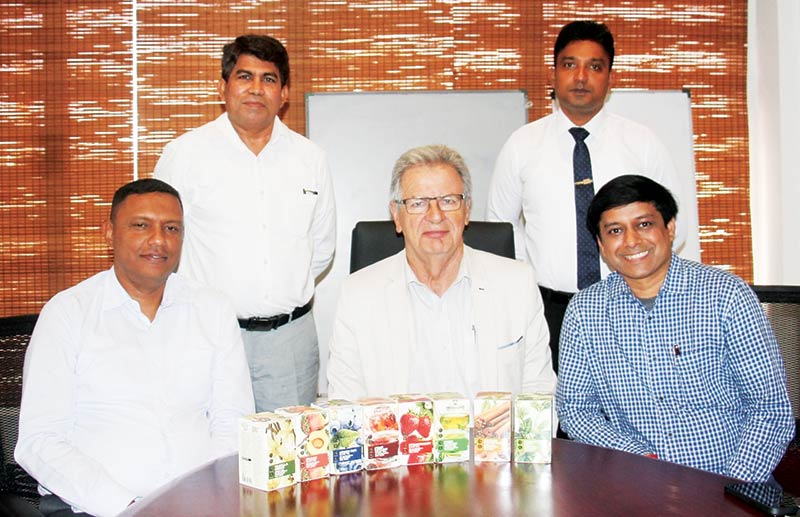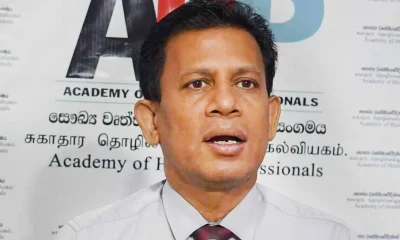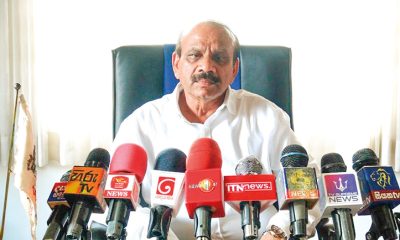Business
Hatton Plantations looks to gain on its robust capital structure

Looking for opportunities to invest in tourism and solar power verticals
Says ‘would be happy to talk to right partners’
By Sanath Nanayakkare
Getting a more realistic control over historical truth and the current significance of a company will probably be the prime concern of a potential investor looking for a strategic tie-up with a particular company, before he or she decides to invest in it.
In that context, Hatton Plantations may not have a ‘story’ to tell, but rather a ‘credible report’ to present because many investors might be cynical about listening to stories.
Hatton Plantations PLC is a subsidiary of G&G Group of Companies, a Singapore-based conglomerate whose chairman is Gary Seaton from Australia who first visited Sri Lanka in the 1970s as a backpacker tourist. Then he and his family started looking at business opportunities in Sri Lanka in the 1980s and bought the first tea company in 1996 after the plantations privatization programme came into effect in Sri Lanka. That was the well-known Pussellawa Plantations spanning across 10,000 hectares.
Then they sold it in 2017 and bought Hatton Plantations (HPL PLC) in 2019 which has 7,500 hectares on 13 estates.
Today HPL PLC has 12 tea processing factories with a combined green leaf capacity of 155,500 kg per day. It uses Orthodox, CTC, Leafy, and Green Tea manufacturing methods supported by versatile production facilities. It engages in the production of high and medium-grown teas in the key regions of Watawala, Hatton, and Lindula.
Hatton Plantations PLC, was the highest producer amongst all the Regional Plantation Companies (RPCs), having sold a quantity of 6,484,037.50 kgs with an average of Rs.1,134.11 for the year 2024, preceded by equal performances in the three previous years. And HP PLC is one company that has been replanting for the past four years continuously – a key factor that has contributed to its continuous growth.
Speaking to the media at the Company’s office in Peliyagoda recently, Gary Seaton said. “We have a vision to further expand into plantation, and we also look at two other business verticals: renewable energy and tourism. We very much believe in transitioning from fossil fuels to renewables. Sri Lanka is one of those few remaining countries that hasn’t industrialized everything and that’s very much aligned with the vision of Hatton Plantations PLC. We understand the challenges Sri Lanka faced in the last 40 years. But despite those challenges, we are with Sri Lankans. Many Sri Lankans are leaving Sri Lanka to go abroad, but we are coming from abroad to operate from Sri Lanka. We are doing it the other way around,” he said on a lighter note.
Menaka Athukorala, CEO & MD Hatton Plantations PLC said,” As part of the diversification, we are going into coffee in a major way. We initiated this project three years ago and we have already planted coffee on 100 hectares, and we are already harvesting coffee. A total of 500 hectares of coffee will be planted in the next 3 to 4 years. Our total investment in coffee would be Rs. 1 billion and we have already invested Rs. 200 million. With this, our per hectare income grows with the optimum use of the land while getting the best productivity from our workforce in a mutually beneficial way.” he said.
Gowri Shankar, CEO G&G Group of Companies, Singapore noted,” There’s a shortage of coffee in India, so it will be a potential market for our unique Sri Lankan coffee brand apart from the U.S., and Australia markets. South India loves coffee over tea and North India’s preferred beverage is tea. So, our coffee has a great opportunity to enter the South Indian market. Hence, we are looking at these three key markets for exporting our coffee.”
“Some other companies also have started growing coffee, but we are the largest producer of coffee at present. We will be setting up our coffee processing unit in the next two years which will cost about Rs. 200- 300 million. By 2026, HPL PLC’s coffee will come to the local market and exports will commence in 4 years down the line”, Menaka Athukorala said.
Touching on their tea plantations, HPL PLC said that they have started deploying mechanization, precision agriculture and tech solutions to make their operations more efficient.
HPL has already started using drone technology to apply Foliar Spray on some of their estates to deliver essential nutrients directly to the tea leaves.
“Drones are being used in pilot projects to streamline the operational process, to increase the productivity in the fields and to make the monitoring more efficient and automative,” they said.
“We are upgrading the facilities being provided to our field workforce with convenient access to toilets and bathing places. We have a workforce of 4,000 on permanent basis and an equal number on a casual basis. The issue of labour wages has not caused us much of a problem because we have so many welfare activities that ensure our workers’ well-being.”
“We are going to set up a vocational training institute on our estate in Hatton to train the children of our workers in various crafts. With the new-found skills, they can choose to work with us or go and be employed or self-employed elsewhere. We believe such socially responsible activities will foster stronger bonds between the company and the employees. That bond will take care of the whole ecosystem of Hatton Plantations for many years to come,” they said.
“For diversification in tourism, we are looking at strategic partnerships whose mainstream business is tourism. We don’t want to get into their line of business. As the infrastructure is already there with HPL’s holiday bungalows and picturesque tea estates, we will see who understands its value and bring their expertise of tourism to our assets. We will see how we can leverage those assets together with them and grow the business,” Gowri Shankar said.
Hatton Plantation PLC’s profit before tax was Rs. 1.2 billion in 2024. This year it will be slightly less because of the wage increase, and it is expected to be close to one billion rupees in FY 2024/25. And in FY 2025/26, the company expects a PBT of Rs. 1.3 billion when tech modernizations are successfully implemented.
“We have liquid cash assets that we would like to channel into these verticals. In the meantime, we are looking at the possibility of investing in tea plantation in Kenya as there is an opportunity to produce orthodox leafy teas in that country – where your yields are higher and profit margins are much greater,” they said.
The media was told that HPL was keen on investing in viable solar power projects anywhere in Sri Lanka that generates more than 5 megawatts of power.
Currently, HPL has eight hydro-power plants generating 12 megawatts. Lotus Hydro Power of the Group is the highest dividend-yielding company in the domain with around 14% yield rate, consistently maintaining it from 2014, except for the crisis-years in Sri Lanka.
“Hatton Plantations is willing to allocate Rs. 1 billion to invest in a viable solar project and we’d be happy to talk to the right partners”, “Gary Seaton said.
Business
Real economic data isn’t in a report: It’s on a bargain table

If you want to understand Sri Lanka’s economy, don’t start with reports from the Ministry of Finance or the Central Bank. Go instead to a crowded clothing sale on the outskirts of Colombo.
In places like Nugegoda, Nawala, and Maharagama, temporary year-end sales have sprung up everywhere. They draw large crowds – not just bargain hunters, but families carefully planning every rupee. People arrive with SMS alerts on their phones and fixed budgets in their minds. This is not casual shopping. It is a public display of resilience, a tableau of how people are coping.
Tables are set up in parking lots and open halls, clothes spilling from cardboard boxes. When new stock arrives, hands reach in immediately – young and old, men and women – searching for the right size, the least faded colour, the smallest flaw that justifies the price. Everyone is heard negotiating, not with desperation, but with a quiet, shared dignity.
“Look at the prices in the malls, then look here,” says a middle-aged mother shopping for school uniforms in Maharagama. “This isn’t shopping for enjoyment. This is about managing life.” Food prices have already stretched her household budget thin. Here, she can buy trousers for half the usual price.
Women, often the household’s purchasing managers, move with determined efficiency. Men are just as involved – checking stiches, comparing prices, trying shirts over their own clothes. Inflation, here, wears the same face on everyone.
Bright banners promise “Trendy Styles!”, but most shoppers know better. These are last season’s clothes, cleared out to make room for next year’s stock. Still, no one feels embarrassment. “New” now simply means something you didn’t own before; the label matters far less than the price.
Not all items are discounted equally. Essentials – work trousers, denims, track pants – are only slightly cheaper. Sellers know these will sell regardless. The steepest discounts are reserved for the items people can almost afford to skip.
This is economic data you won’t find in official reports. Here, inflation is measured in real time. A young man studies a shirt’s price tag and calculates how many days of work it represents. Friends debate whether a slight fade is a fair trade for the price. Every transaction is a careful calculation.
Year-end sales have always existed. But since the economic crisis, they have taken on a new, grim significance. They offer a slight reprieve to households learning to steadily lower their aspirations. While the government speaks of fiscal discipline and a steady Treasury, everyday life remains a tightrope walk.
The Central Bank measures inflation in percentages. On the streets of Kiribathgoda, it is measured in trade-offs: one item instead of two; buying now or waiting for the Avurudu season; choosing need over want, again and again.
As evening falls, the crowds thin. The tables are left rumpled, hangers scattered like fallen leaves. Yet these spaces tell a story more powerful than any quarterly report – a story of business ingenuity, household struggle, and an economy where every single purchase is weighed with immense care.
In that careful weighing lies a quiet, unsettling truth. No matter what is said about replenished reserves or balanced budgets, these bargain tables – if they could speak – would tell the nation’s most heart-rending story. And they do, to anyone who chooses to listen.
By Sanath Nanayakkare
Business
Global economy poised for growth in 2026, says Goldman Sachs, despite uneven job recovery

The global economy is forecast to expand by a “sturdy” 2.8% in 2026, exceeding consensus expectations, according to the latest Macro Outlook report from Goldman Sachs Research. This optimistic projection highlights a resilient recovery trajectory across major economies, albeit with significant regional variations and a persistent disconnect with labour market strength.
Goldman Sachs economists are most bullish on the United States, expecting GDP growth to accelerate to 2.6%, substantially above consensus estimates. This optimism stems from anticipated tax cuts, easier financial conditions, and a reduced economic drag from tariffs. The report notes that consumers will receive approximately an extra $100 billion in tax refunds in the first half of next year, providing a front-loaded stimulus. A rebound from the past government shutdown is also expected to contribute to what chief economist Jan Hatzius predicts will be “especially strong GDP growth in the first half” of 2026.
China’s economy is projected to grow by 4.8%, underpinned by robust manufacturing and export performance. However, economists caution that parts of the domestic economy continue to show weakness. In the euro area, growth is forecast at a modest 1.3%, supported by fiscal stimulus in Germany and strong growth in Spain, despite the region’s longer-term structural challenges.
A key concern outlined in the report is the stagnant global labour market. Job growth across all major developed economies has fallen well below pre-pandemic 2019 rates. Hatzius links this weakness partly to a sharp downturn in immigration, which has slowed labour force growth, with the disconnect being most pronounced in the United States.
While artificial intelligence (AI) dominates technological discourse, Goldman Sachs economists believe its broad productivity benefits across the wider economy are still several years away, with impacts so far largely confined to the tech sector.
Business
India trains Sri Lankan gem and jewellery artisans in landmark capacity-building programme

A 20-member delegation of professionals from Sri Lanka’s Gem and Jewellery sector visited India from 1–20 December 2025 to participate in a specialised Training and Capacity Building Programme. The delegation represented the gemstone cutting and polishing segments of Sri Lanka’s Gem and Jewellery industry.
The programme was organised pursuant to the announcement made by Prime Minister of India, Narendra Modi, during his visit to Sri Lanka in April 2025, under which India committed to offering 700 customised training slots annually for Sri Lankan professionals as part of ongoing bilateral capacity-building cooperation.
The 20-day training programme was conducted by the Government of India at the Indian Institute of Gem & Jewellery, Jaipur, Rajasthan. The curriculum comprised a comprehensive set of technical and thematic sessions covering the entire Gem and Jewellery value chain. Key modules included cleaving and sawing, pre-forming, shaping, cutting and faceting, polishing, quality assessment, and industry interactions, aimed at strengthening practical skills and enhancing design and production capabilities.
As part of the experiential learning component, the participants undertook site visits to leading gemstone manufacturing units, gaining first-hand exposure to contemporary production technologies, design development processes, and modern retail practices within India’s Gem and Jewellery ecosystem.
The specialised training programme contributed meaningfully to strengthening professional competencies, promoting knowledge exchange, and deepening institutional and industry linkages in the Gem and Jewellery sector between India and Sri Lanka, reflecting the continued commitment of both countries to capacity building and people-centric economic cooperation.
-

 News7 days ago
News7 days agoMembers of Lankan Community in Washington D.C. donates to ‘Rebuilding Sri Lanka’ Flood Relief Fund
-

 News5 days ago
News5 days agoBritish MP calls on Foreign Secretary to expand sanction package against ‘Sri Lankan war criminals’
-

 Features7 days ago
Features7 days agoGeneral education reforms: What about language and ethnicity?
-

 News7 days ago
News7 days agoSuspension of Indian drug part of cover-up by NMRA: Academy of Health Professionals
-

 Sports5 days ago
Sports5 days agoChief selector’s remarks disappointing says Mickey Arthur
-

 News4 days ago
News4 days agoStreet vendors banned from Kandy City
-

 Editorial7 days ago
Editorial7 days agoA very sad day for the rule of law
-

 News7 days ago
News7 days agoUS Ambassador to Sri Lanka among 29 career diplomats recalled













